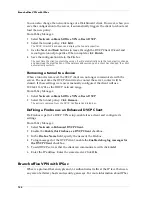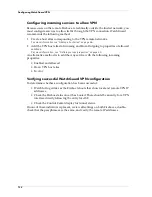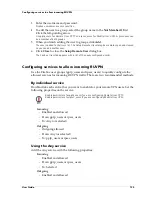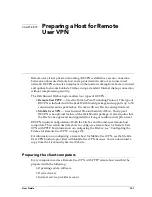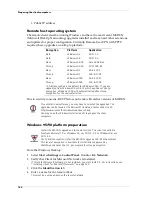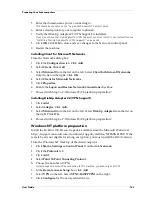
Configuring shared servers for RUVPN
134
• The IP addresses of the DNS and WINS servers in the trusted network that
perform IP address lookup on host alias names.
• The usernames and passwords of those authorized to connect to the Firebox
using RUVPN.
• For Mobile User VPN, you will also need:
- Mobile User VPN license key
- Target Firebox upgraded to strong or medium encryption
Configuring shared servers for RUVPN
RUVPN clients rely on shared Windows Internet Name Server (WINS) and Domain
Name System (DNS) server addresses. For information on configuring these servers,
see “Entering WINS and DNS server addresses” on page 40.
Adding remote access users
The Firebox configuration file automatically includes two Firebox User groups called
pptp_users and ipsec_users. When a remote host connects and creates a tunnel,
Policy Manager authenticates the username against the list of members for the group
associated with the tunnel type. In other words, an incoming PPTP tunnel would
authenticate against the pptp_users group.
Once authenticated, the Policy Manager then adds the remote client IP address to the
group. Use the Firebox User group to configure services for incoming and outgoing
RUVPN traffic.
Because of the way Windows holds the username and password for subsequent
logins, one option to reduce end-user confusion is to assign the same RUVPN login
and password as those used for Windows NT login and password. This method,
however, is less secure than using multiple passwords.
Adding a member to built-in RUVPN user groups
The process to add a member to the built-in RUVPN user groups is the same for both
PPTP and IPSec. The example below is for pptp_users. From Policy Manager:
1
Select
Setup => Authentication
.
2
Click the
Firebox Users
tab. To add a new user, click the
Add
button beneath the
Users list.
There is also a button to access the Setup Firebox User dialog box from within the Mobile User
VPN wizard.
RUVPN users must be added as Firebox users even if another authentication
method is used internally.
Summary of Contents for Firebox FireboxTM System 4.6
Page 1: ...WatchGuard Firebox System User Guide Firebox System 4 6 ...
Page 16: ...6 ...
Page 20: ...LiveSecurity broadcasts 10 ...
Page 44: ...LiveSecurity Event Processor 34 ...
Page 52: ...Defining a Firebox as a DHCP server 42 ...
Page 68: ...Service precedence 58 ...
Page 78: ...Configuring a service for incoming static NAT 68 ...
Page 92: ...Establishing an OOB connection 82 ...
Page 94: ...84 ...
Page 112: ...HostWatch 102 ...
Page 118: ...Working with log files 108 ...
Page 130: ...120 ...
Page 158: ...Configuring debugging options 148 ...





